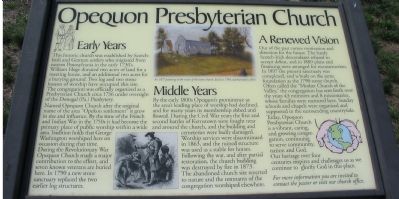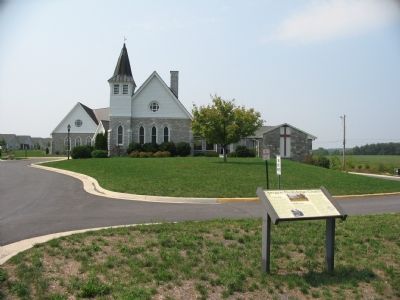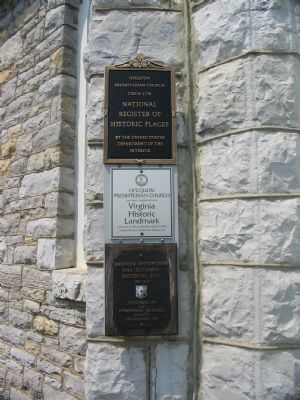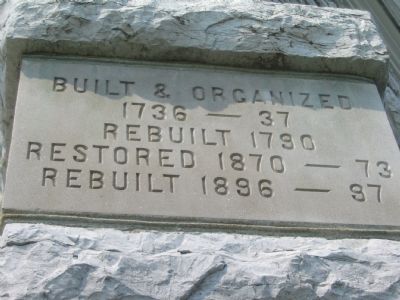Near Winchester in Frederick County, Virginia — The American South (Mid-Atlantic)
Opequon Presbyterian Church
American Presbyterian and Reformed Historical Site
Early Years
This historic church was established by Scotch-Irish and German settlers who migrated from eastern Pennsylvania in the early 1730’s. William Hoge donated two acres of land for a meeting house, and an additional two acres for a burying ground. Two log and two stone houses of worship have occupied this site. The congregation was officially organized as a Presbyterian Church circa 1736 under oversight of the Donegal (Pa.) Presbytery. Named Opequon Church after the original name of the area “Opekon settlement” it grew in size and influence. By the time of the French and Indian War in the 1750s it had become the primary place of public worship within a wide area. Tradition holds that George Washington worshiped here on occasion during that time. During the Revolutionary War Opequon Church made a major contribution to the effort, and seven known veterans are buried here. In 1790 a new stone sanctuary replaced the two earlier log structures.
Middle Years
By the early 1800s Opequon’s prominence as the area’s leading place of worship had declined, and for many years its membership ebbed and flowed. During the Civil War years the first and second battles of Kernstown were fought near and around the church, and the buildings and cemeteries were badly damaged. Worship services were discontinued in 1863, and the ruined structure was used as a stable for horses. Following the war, and after a partial restoration, the church building was destroyed by fire in 1873. The abandoned church site reverted to nature and the remnants of the congregation worshiped elsewhere.
A Renewed Vision
Out of the past comes motivation and direction for the future. The hardy Scotch-Irish descendants refused to accept defeat, and in 1889 plans and financing were arranged for reconstruction. In 1897 the present sanctuary was completed, and is built on the same foundation as the 1790 stone church. Often called the “Mother Church of the Valley,” the congregation has set forth over the years 43 ministers and 8 missionaries, whose families were nurtured here. Sunday schools and chapels were organized and supported in the surrounding countryside. Today, Opequon Presbyterian Church is a vibrant, caring, and growing congregation, continuing to serve community, nation, and God. Our heritage over four centuries inspires and challenges us as we continue to glorify God in this place.
For more information you are invited to contact the pastor or visit our church office (Marker Number 169.)
Topics and series. This historical marker is listed in these topic lists: Churches & Religion • Settlements & Settlers. In addition, it is included in the American Presbyterian and Reformed Historic Sites series list. A significant historical year for this entry is 1736.
Location. This marker has been replaced by another marker nearby. It was located near 39° 8.364′ N, 78° 11.71′ W. Marker was near Winchester, Virginia, in Frederick County. Marker was on Opequon Church Lane, in the median. Located in front of the Church in the north side parking lot. Touch for map. Marker was at or near this postal address: 217 Opequon Church Lane, Winchester VA 22602, United States of America. Touch for directions.
Other nearby markers. At least 8 other markers are within walking distance of this location. 1790 Stone Church (a few steps from this marker); In Memory of the Many Soldiers of the Revolution (a few steps from this marker); In Memory of William Hoge (1660 - 1749) and His Wife Barbara Hume Hoge (1670 - 1745) (within shouting distance of this marker); a different marker also named Opequon Presbyterian Church (within shouting distance of this marker); Battle of Kernstown (about 300 feet away, measured in a direct line); a different marker also named Battle of Kernstown (about 300 feet away); Kernstown Battles (about 300 feet away); a different marker also named Battle of Kernstown (about 300 feet away). Touch for a list and map of all markers in Winchester.
More about this marker. In addition to artwork and an untitled drawing of early settlers appearing to prepare church plans, there is “An 1877 painting of the ruins of the stone church, built in 1790 and burned in 1873.”
Regarding Opequon Presbyterian Church. Opequon Presbyterian Church was listed in the National Register of Historic Places in 2001. This church is also one of 445 American Presbyterian and Reformed Historical Sites registered between 1973 and 2003 by the Presbyterian Historical Society (PHS), headquartered in Philadelphia. Approved sites received a metal plaque featuring John Calvin’s seal and the site’s registry number (PHS marker among other markers located in front of the church building).
The following text is taken from the Presbyterian Historical Society website:
One of the oldest continuing Presbyterian congregations west of the Blue Ridge Mountains, Opequon Church began in 1736 under the leadership of Rev. Samuel Gelston of Donegal Presbytery. Rev. John Hoge, son of William Hoge, who donated the land for a church and cemetery, was pastor here from 1755 to 1772. Two log buildings served the congregation until 1790, when a large stone church was constructed. During the Battle of Kernstown, Civil War soldiers carved a checkerboard on the present communion table. The current church building, dedicated in 1897, is a reconstruction of the previous structure, destroyed by fire in 1873. The congregation renovated the church and added an educational building in 1956.
Related marker. Click here for another marker that is related to this marker. This marker has been replaced by the linked marker.
Also see . . .
1. Opequon Presbyterian Church. Wikipedia entry (Submitted on July 8, 2022, by Larry Gertner of New York, New York.)
2. Opequon Presbyterian Church. Church website homepage (Submitted on September 20, 2007, by Craig Swain of Leesburg, Virginia.)
3. Opequon Presbyterian Church. Virginia Department of Historic Resources website entry (Submitted on September 20, 2007, by Craig Swain of Leesburg, Virginia.)
Credits. This page was last revised on July 8, 2022. It was originally submitted on September 20, 2007, by Craig Swain of Leesburg, Virginia. This page has been viewed 2,742 times since then and 45 times this year. Last updated on August 20, 2018, by Douglass Halvorsen of Klamath Falls, Oregon. Photos: 1, 2, 3, 4. submitted on September 20, 2007, by Craig Swain of Leesburg, Virginia. • Bill Pfingsten was the editor who published this page.



